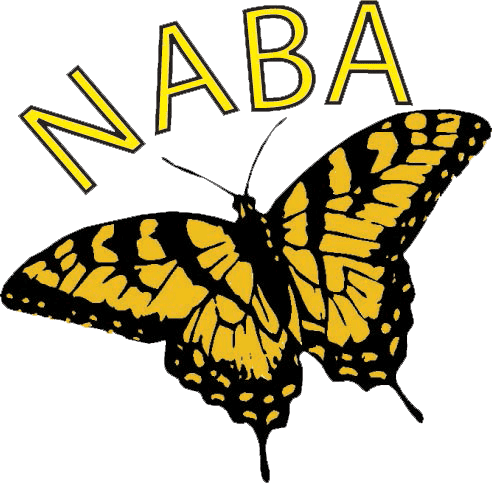![]()
Butterfly Feeder Report from New Jersey
In their book, How to Spot Butterflies, authors Pat and Clay Sutton state that “quite a few butterflies and moths have odd preferences and are attracted to feces, urine, sap, and rotten fruit.” While this may seem a stark contrast to the visual beauty of butterflies, the Suttons have had great success in exploiting this feeding behavior by using a homemade butterfly feeder filled with watermelon, gooey bananas or other fruit that is past its prime.

The butterfly feeder in their southern New Jersey garden is often filled with “banana
goo” made from bananas that have been peeled, frozen, then defrosted. Once defrosted, the bananas become soft and watery. Pat notes the fruit in the feeder needs to be gooey in order to attract a lot of butterflies. After a few hot days, the goo may need to be moistened with some fruit juice to keep it from drying out.
Red-spotted Purple, Red Admiral, Question Mark, Eastern Comma, Mourning Cloak, Common Wood Nymph, Little Wood-Satyr, Appalachian Brown, Hackberry Emperor, and Tawny Emperor butterflies have all visited the Sutton’s feeder to dine on goo.Even though Pat and Clay have an extensive butterfly/hummingbird garden, they don’t often see these aforementioned butterflies in their garden and have concluded that including a butterfly feeder in their garden greatly enhances their local habitat for butterflies.
Butterfly feeders certainly attract local butterflies down from the trees to a central viewing area but feeders may also give a glimpse of the unusual. The rarest butterfly that has been attracted to the feeder in Suttons’ Cape May County garden is a Gray Comma (seen on July 15, 1999). This butterfly was more than 100 miles out of habitat and most likely more than 250 miles away from its permanent range.

Once the temperatures in the spring start to hover in the mid-50s for extended periods, Pat places the feeder outdoors to attract over wintering species such as Mourning Cloaks and Question Marks. The number of early season of butterflies is small but increases as the weather warms up. The Suttons leave their feeder outside until fall temperatures become too cold for butterflies.
Other feeder visitors that are fun to watch include: Ruby-throated Hummingbirds which feed on fruit flies that hover near the fruit and a variety of moths that come at night. By shining a flashlight on the feeder at night, the moths’ eyes will reflect a variety of colors.
Pat offers the following insights from her experiences with butterfly feeders:
- Use a simple ceramic dish with a lip and suspend it from an old plant hanger. Marketing people have jumped on the bandwagon and sell contraptions labeled as butterfly feeders but they do not seem to be an improvement over the more simple, homemade versions.
- Try to have a lot of goo (ripe fruit with liquid) in a large shallow dish, about the size of a dinner plate. The dish should not have drainage holes; you are looking for a large surface area of goo so that a number of butterflies can feed at the same time.
- Rotten fruit can be found by asking for it! Pat collects fruit past its prime for free from a local farm stand. She notes that she has to collect it often as the farm stand staff do not enjoy keeping rotting fruit sitting around.
- Pat places her dish of goo just outside a window, suspended from a plant hanger attached to a tree. By placing the feeder near her window, it is easy to watch the butterflies. Hanging in the tree, the feeder dish is less likely to attract ants or hungry mammals. If animals become a problem, the feeder can be stored at night in an outdoor shed and brought out during the day.
- The Suttons have placed feeders in shady locations, like the one outside their window, and also in sunny locations. Both locations seem to attract butterflies but the feeder in the sunny location will need to be watched a bit more carefully so that it does not dry out.
